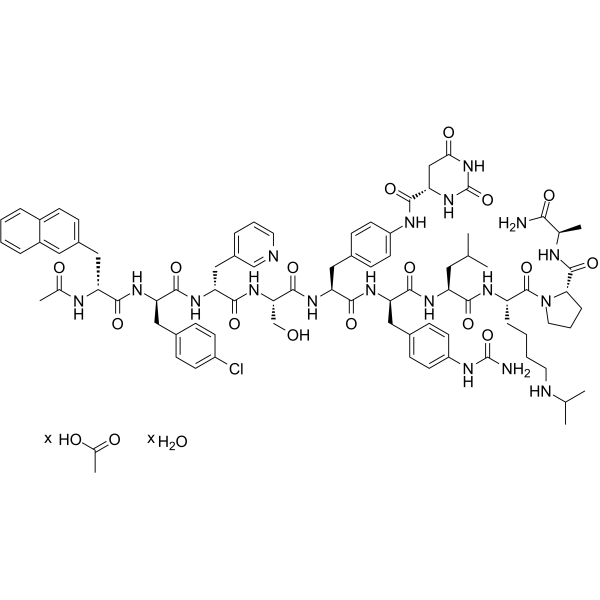| In Vitro |
Degarelix shows only very weak histamine-releasing properties and the lowest capacity for histamine release among the antagonists of LHRH, including Cetrorelix (HY-P0009), Abarelix (HY-13534), and Ganirelix (HY-P1628)[1]. Degarelix (1 nM-10 μM, 0-72 h) reduces cell viability in all prostate cell lines (WPE1-NA22, WPMY-1, BPH-1, VCaP cells), with the exception of the PC-3 cells[2]. Degarelix (10 μM, 0-72 h) exerts a direct effect on prostate cell growth through apoptosis[2]. Cell Viability Assay[2] Cell Line: WPMY-1, WPE1-NA22, BPH-1, LNCaP and VCaP Concentration: 1 nM-10 μM Incubation Time: WPMY-1 cells at 48 and 72h, WPE1-NA22 cells at 72 hours, BPH-1 cells at 48 and 72h, LNCaP cells at 48 and 72h Result: Reduced cell viability in all prostate cell lines, with the exception of the PC-3 cells. Apoptosis Analysis[2] Cell Line: WPE1-NA22, BPH-1, LNCaP and VCaP Concentration: 10 μM Incubation Time: 24, 48 and 72 h Result: Induced a significant increase on caspase 3/7 activation.
|
| In Vivo |
Degarelix (0-10 μg/kg; s.c.; once) decreases plasma LH levels and plasma testosterone levels in a dose-dependent manner in castrated rats[3]. Degarelix is stable when incubated in microsomes and cryopreserved hepatocytes from animal liver tissue. In rat and dog, most of the degarelix dose is eliminated within 48 h via urine and feces in equal amounts (40–50% in each matrix), whereas in monkey the major route of excretion is fecal (50%) and renal (22%)[4]. Animal Model: Male Sprague-Dawley rats, castrated[3] Dosage: 0.3, 1, 3 and 10 μg/kg or 12.5, 50, and 200 μg/kg Administration: Subcutaneous injection, once Result: Produced a dose-dependent and reversible decrease in plasma LH levels with a minimal effective dose of 3 μg/kg. For the 50 μg/kg and 200 μg/kg doses, t1/2 of absorption values were 4 min and 30 min, Tmax values were 1 h and 5 h, and apparent plasma disappearance t1/2 values were 12 h and 67 h, respectively. Produced a dose-dependent decrease in plasma testosterone levels with a minimal effective dose of 1 μg/kg.
|
